Studying in Spain: how to negotiate the entry requirements
Determining whether a student fulfils the entry requirements for the degree they want to study at a Spanish university can be tricky – but this guide illuminates the process

There are two types of university in Spain: public and private.
Spanish public universities usually offer very traditional education, where lectures are the main form of teaching and students and teachers have very little interaction.
The cost of Spanish public universities is low compared with universities in other countries. Usually the cost is about €1,200 (£1,025) for tuition each year for EU and non-EU students alike.
Private universities are also not as expensive as their non-Spanish counterparts: between €6,000 and €28,000 per year, depending on the university and the degree. Private universities often offer merit-based scholarships.
Applying to Spanish universities: why grades matter
All public and (most) private universities in Spain are not really interested in best fit. Often the motivation and recommendation letters are a box that needs to be checked, but are not actually used to define whether a student really fits at the school.
Universities that require an interview appear to be much more concerned about whether a student will feel at home and perform well at their institution.
How to apply to Spanish universities
Private universities
Applying to private universities is very straightforward. Applications should be made directly to the university. Students need to submit their transcripts of grades 10 and 11 (Years 11 and 12) and sometimes the first term of grade 12 (Year 13). Occasionally, universities will request a letter of recommendation, motivation letter or CV as well. A few private universities, such as Esade Business and Law School, will request an interview.
Universidad Católica de Murcia, despite being a private university, follows the same system as public universities.
Public universities
It is possible to obtain direct access to Spanish public universities with the IB diploma in several Spanish comunidades, such as Madrid, Basque Country, Valencia, Asturias, Canarias, Castilla-La-Mancha, Extremadura, La Rioja and Navarra. However, determining whether a student fulfils the entry requirements for the degree they want to study can be somewhat complex.
The entry requirements are based on two parts: students’ overall IB grade and whether they have taken two subjects from a list of ponderaciones – comparable to prerequisites – as well as their grades in these two subjects or ponderaciones.
Does my student have the right entry requirements?
To find out which IB subjects students need to have for the degree of their choice, type “ponderaciones + [name of university]” into any search engine. Always check the ponderaciones for the year the particular student will start their degree.
The university will provide a grid with the list of degrees offered at the university in question and the ponderaciones required for each subject. Where it says “0.2”, this means that the grade in this subject is fully counted; “0.1” signifies that it will only count for half the grade.
The table below illustrates ponderaciones required for Universidad Carlos III, in Madrid:
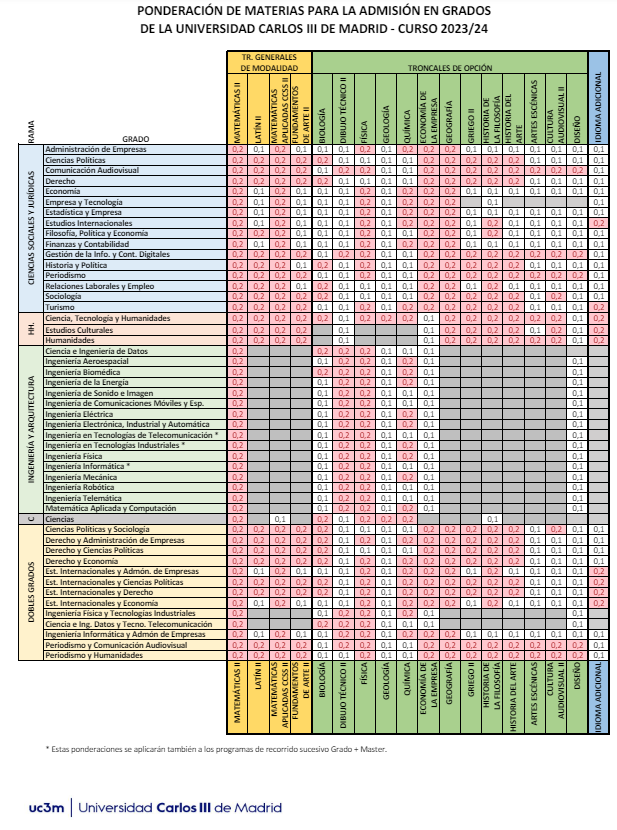
IBDP subject recognition
Matematicas II: Maths AA HL
Latin II: Classical languages SL or HL
Matemáticas aplicadas: Maths AI SL or HL
Fundamentos de arte II: Visual arts SL or HL
Biologia: Biology SL or HL
Fisica: Physics SL or HL
Quimica: Chemistry SL or HL
Economia de la Empresa: Business SL or HL
Geografia: Geography SL or HL
Historia de la filosofía: Philosophy SL or HL
You can find this information for other IB subjects here, as well under “Reconocimiento de asignaturas cursadas o evaluadas y aprobadas en su sistema educativo”. Choose “Programa Del Diploma IB”.
Important: maths AA SL, economics, psychology and ESS are not recognised as ponderacion at any Spanish public university.
What grades will my student need?
At the start of every academic year, the previous year’s cut-off grades for each degree at each public university are published. These grades are called notas de corte, and they give an indication of what grades a high-school student should be achieving in order to be admitted.
To find the notas de corte of each university, you just type in “nota de corte + name university + year” on any search engine. Make sure to click on the “nota de corte” link of the university.
Notas de corte of 2023-24 at Universidad Carlos III (Madrid):
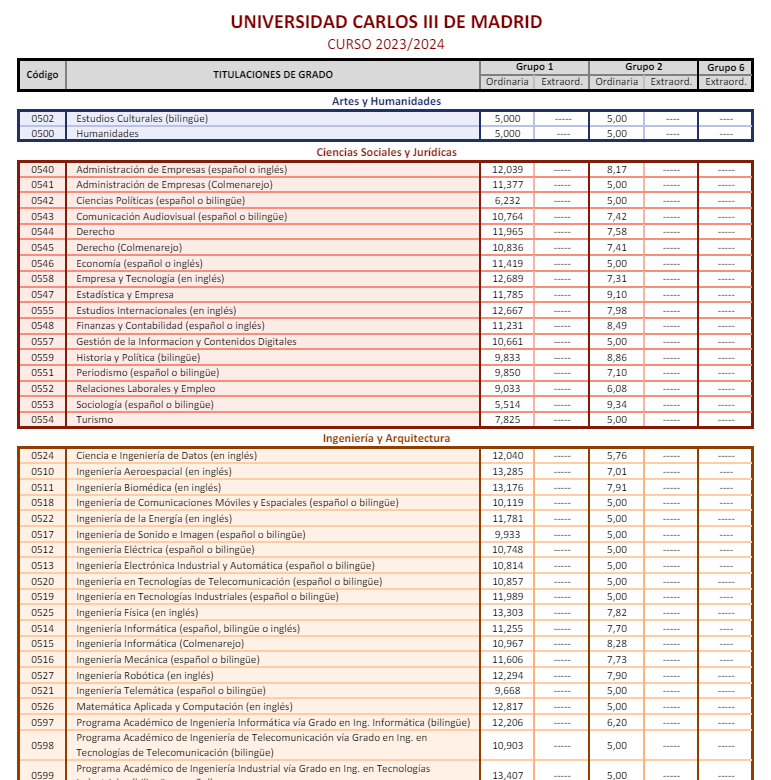
Usually high-school students are part of Grupo 1. You can see that at Carlos III, the cut-off grade for Ciencia e Ingeniería de Datos (bachelor’s in science and data engineering) in 2023-24 was 12,040.
Calculating the nota de corte of an IB student happens in two steps:
Step one
For step one, you use the following conversion table:
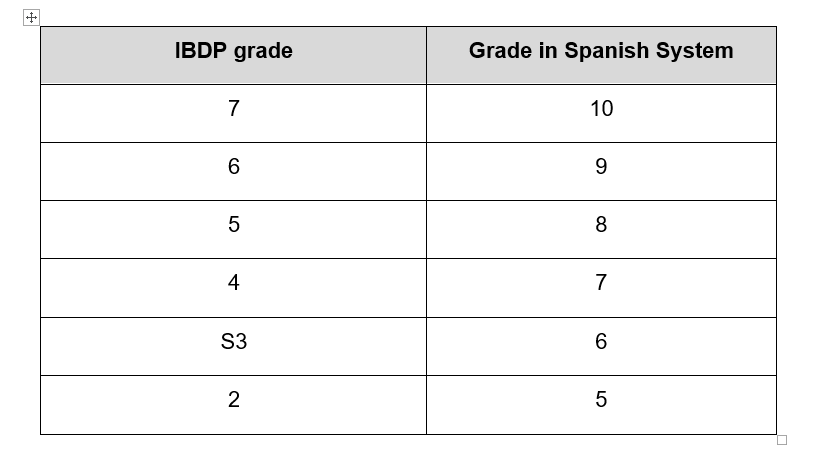
You convert the grade for each subject, add up these six grades and divide them by six.
IB student example:
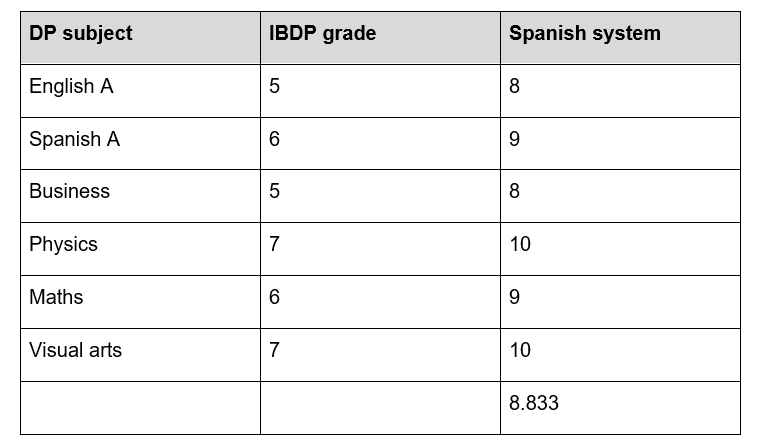
This student has 8.833 out of 10 as a nota de corte (step one only). But notas de corte are calculated as a score out of 14.
Step two
In step two, the grades of the ponderaciones – the prerequisite subjects – will be added. A different conversion is used: each of these two subjects will add a maximum of two points to the nota de corte.
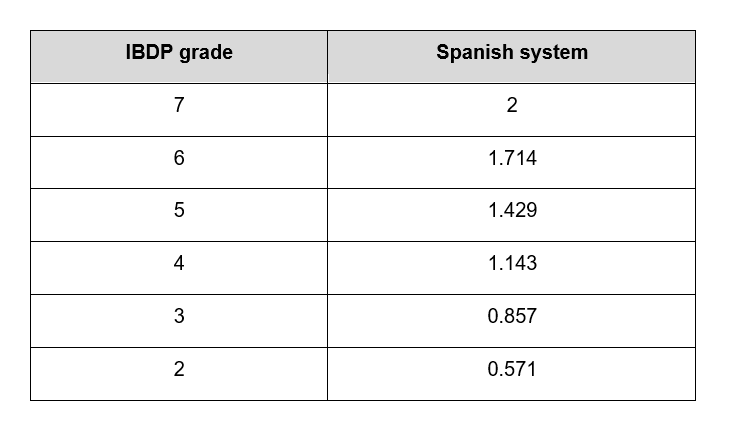
Based on the previous IB student example, if this student needed physics and maths as their ponderaciones, then 3,714 (2 + 1,714) would be added to their nota de corte out of 10, which gives the student a total nota de corte of 12.547.
As a result, this IB student should be eligible for admission to the bachelor’s degree in science and data engineering at Carlos III Universidad.
In case that seemed too straightforward...
A student’s predicted or term grades could be used for an initial calculation, but the grades that will count for the admissions process are the actual IB grades the student achieves.
In the Spanish comunidades Andalucía, Aragón, Cantabria, Castilla y Leon, Catalunya, Galicia, Islas Baleares and Region de Murcia, IB grades don’t count for step two. Therefore, students need to take at least two additional exams to obtain grades for their ponderaciones.
The official verification of the student’s IB diploma will be done by UNED: the biggest public university in Spain. UNED is the organisation that carries out the verification of all international high-school diplomas for higher education in Spain.
Contact UNED to verify whether high-school diplomas besides the IBDP and the EBAU (Spanish Baccalaureate) are accepted at Spanish public universities.



